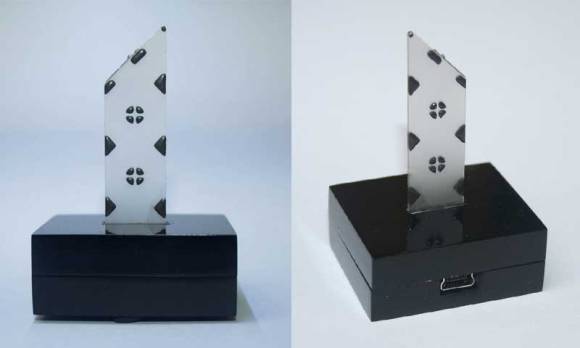
The spire used in this lamp is a part from an old television. It’s a glass delay line slide which pipes the light up from the Bluetooth controlled RGB lamp (translated) in the base.
We have looked at delay lines previously when [Dave Jones] tore down a camcorder to get at one. But we must have missed the EEVblog follow-up episode which explains how the glass slides work. The device uses physical distance to form a delay. Waves directed into the edge of the glass slide bounce around at an angle before being sensed at the collection point. [Lukas] liked the visual appearance of the part and decided to use it to add visual interest to his lamp project. The nature of the glass makes it perfect for directing the light up and away from the PCB.
The lamp consists of one RGB LED module controlled by an ATtiny2313 microcontroller. Also on board is a HC-05 Bluetooth module. This along with an app he wrote lets the user change lamp color and behavior wirelessly. You can see the lamp in action in the video after the break, but we think the camera shot probably doesn’t do it the justice it deserves.














Glass delay line, I never even knew what these were called, but I managed to break one that was part of a printer I believe
You sure that wasn’t a quartz fusing lamp?
All I know is that I have only come across two of these ever and one was definitely from a tv, the other was printer so it could have been something else, I should have been careful but I accidentally broke it but was perplexed by this weird glass layer surrounded in plastic, like wtf is this
what a waste of a perfectly good vintage component that isn’t manufactured anymore.
He could have just cut a piece of acrylic instead …
What do they use now? I saw the teardown by dave but I could wrapt my head around for what they are used. I get the delay-thing, but is there an practical and easy to understand real world example where I would need a delay line in one of my bloody beginner projects?
Likely not anymore. They were mostly used when having the memory to do it was more expensive than making these things. In a cam corder I believe they were used to keep a nearly a single scan line of video before putting it on to the VHS casette. They were used essentially as a very short term memory storage, if you were to put a light and controller before it you could likely use it to store some number of bits by continually receiving and re-sending the information down the line. As much as I hate to see good components go out of use and put into things like this, there isn’t much utility in the component anymore anyway.
Thank you
Testing Cookie Settings…
Now? No idea. They were used in TVs in the analogue times.
From Wikipedia:
A better and more widespread use of piezoelectric delays was in European television sets. The European PAL standard for color broadcasts compares the signal from two subsequent lines in order to avoid color shifting due to small phase shifts. By comparing two lines, one inverted, the shifting is averaged out and returns a signal more closely matching the original even under interference. In order to compare the two lines, a piezo delay tuned to the timing of the lines, 64 µs, is inserted in the signal path.
what a waste of a perfectly good comment space
He could have just kept his mouth shut instead …
Why does this thing remind me of the Light Saber Cheese Knife from Blue Harvest?
Just don’t trip on it.
If you want to find these you can get them in old VCR’s too.
What in the world is a light saber cheese knife??
always wondered what they actually did
i always thought they were a large quartz resonator haha